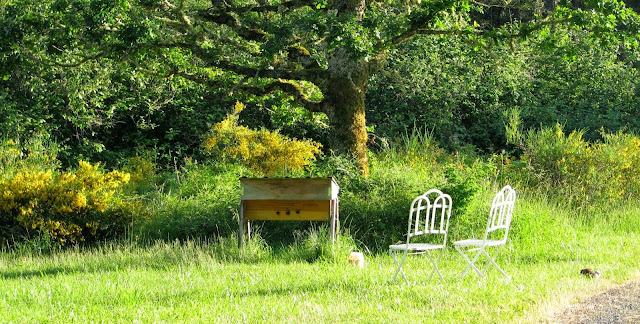They say that the sum total of the life's work of one average honey bee is 1/12 to 1/4 teaspoon of honey and that over 2 million flowers are visited to make one pound of honey. Thinking about this inspired me to look around the Homestead from a bees perspective. Looking at every plant blossom as a potential food source put a new twist on my flower viewing.
 Shasta daisy
Shasta daisy
 Shasta daisy
Shasta daisy
I am told by beekeepers in Western Oregon that the nectar flow from which our bees make a majority of their yearly honey from is, ironically, the invasive and dreaded Himalayan Blackberry (Rubus armeniacus), so named by the famous hybridizer Luther Burbank.
Since it's introduction into the US by Mr. Burbank in 1885 it has invaded woodlands from Hawaii to Australia and continues to weave it's way into every nook and cranny of our acreage as the minutes tick by. It has the unfortunate knack for crowding out native plants, creating mono cultures on our forest floors and destabilizing river and creek banks and causing erosion.
Mr. Burbank, responsible for developing and introducing over 800 strains and varieties of plants, got it right with Burbank potatoes and Santa Rosa plums but he also, unwittingly, saddled the world with the Himalayan Blackberry.
Most of the time we curse it, chop and dig it and untangle it from our bleeding arms.
But then for a brief time in August we have a pleasant sort of amnesia about what a pest it is because there are luscious berries by the buckets full. Then there are blackberries on yogurt for breakfast, blackberries on ice cream and then blackberry pie and amazing blackberry jam if we are feeling industrious.
And now we have another reason to temper our disdain for the plant, our bees survival and the extra honey.
Our bees are well established now and have filled about 15 bars with comb. Most of those combs are filled with brood (different stages of baby bees), but now they are filling fresh white comb with blackberry nectar.

Our bees working away on the honey cells
They will fan the cells full of nectar with their wings until it evaporates to the proper water content for honey and then the cell will be capped as storage for food in the winter.Now that the rainy spring has finally yielded to the hot sun, we are looking at the biggest blackberry blossoms I have seen in a long while. That made me happy for the bees. They'll be able to put a lot of honey away for this winter. Maybe even a little for us too. Perhaps I can feel a tiny bit better about how slowly the blackberry eradication project is going.
Here is a short movie of the bar I pulled from the hive this week. It has mostly open honey cells but the ones in the very top middle are capped. It also has a corner of comb from the next bar. I think I may not have the hive perfectly level. I'm sure the bees fixed the tear right away after I put the bar back.
































